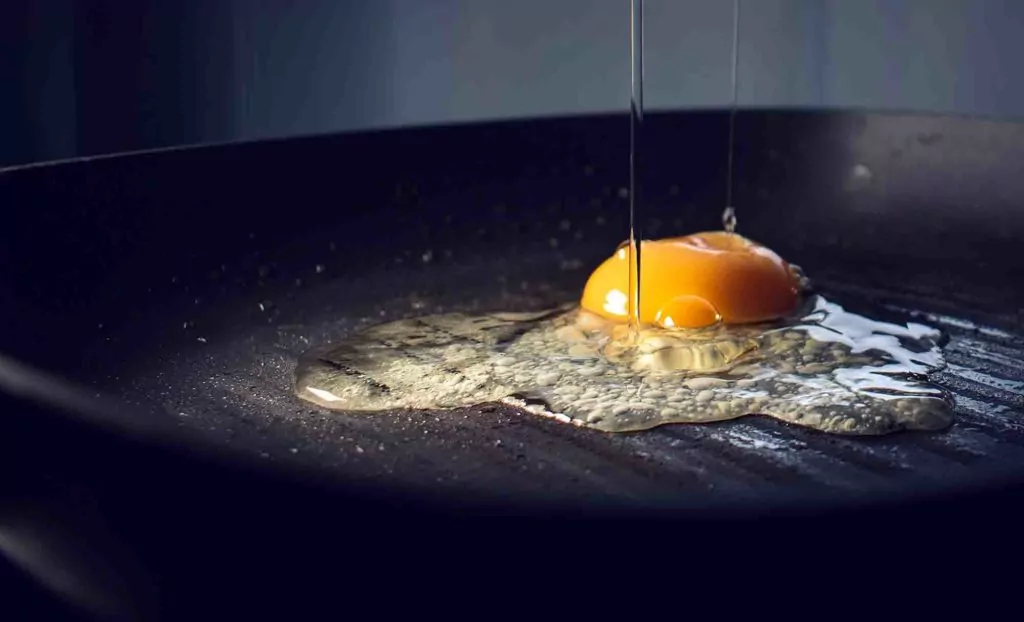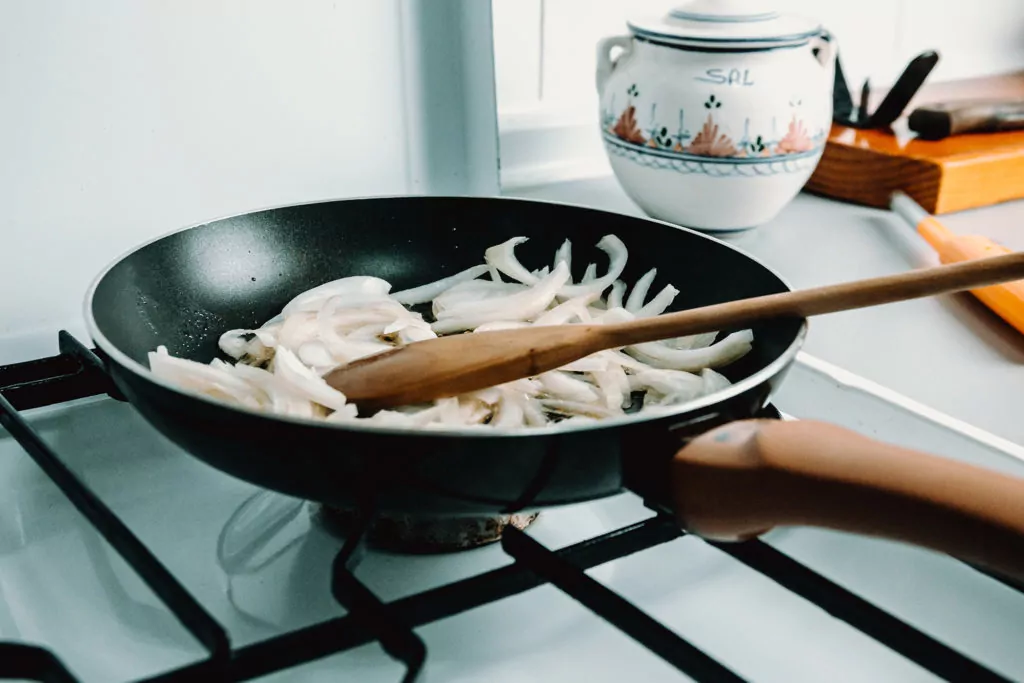There are few things more alluring than the promise of a pan that lets you slide a perfectly cooked egg right onto a waiting plate. The wonder of easy to clean cookware that eliminates burned on messes and the need to soak has helped sell millions of Teflon and PTFE non stick pans. In 2019, the retail sales of non-stick cookware were 1.47 billion dollars. However, as many potential health and environmental hazards associated with non-stick cookware have come to light, consumers are increasingly searching out PFOA and PTFE free non stick pans.

PFOA Vs PTFE
Between the acronyms, scientific jargon and unscrupulous companies actively trying to mislead consumers about the chemical makeup of their pans, it can feel overwhelming to try to make decisions about the safety of non-stick cookware. In this article I will walk you through all of the terms you need to know, help you to understand the risks of PFOA and PTFE and provide safe alternative options.
PFOA is an acronym for Perfluorooctanoic acid and was used in the manufacturing of PTFE until 2014. Perfluorooctanoic acid (PFOA) is a manufactured perfluorochemical that was previously used in the production of PTFE.
PFOA is referred to as a “forever chemical” as it stays in both the environment and in the human body for extremely long periods and may increase risk of cancer and other diseases. Numerous studies have found PFOA to be present in the blood of almost all individuals and the International Agency for Research on Cancer classified PFOA as “possibly carcinogenic to humans”.
Both PFOA and the closely related PFOS are no longer produced in the US as part of a voluntary agreement between manufacturers and the EPA. So any cookware manufactured in the United States will be PFOA free whether or not it is advertised this way.
Companies that still manufacture PTFE pans benefit from consumer confusion between PFOA and PTFE. PTFE is the material itself while PFOA is a chemical that was used in the creation process. PTFE is still widespread and now made with alternative chemicals.
Are Ceramic Pans Safe?
Like Teflon or PTFE nonstick cookware, ceramic pans start as a metal pan that is sprayed with a coating. In the case of ceramic pans, this is a mineral coating that is naturally slick and free of toxins.
A ceramic pan is an excellent and safe option that can be inexpensive. However, there are imposters that you need to watch out for that advertise as ceramic, but still use PTFE. Only purchase items that say they are “100% ceramic” and avoid anything that says it is “ceramica” or another derivative name.
One of the common complaints lodged at ceramic pans is that they aren’t as durable as Teflon pans. If used properly, ceramic pans can be incredibly long lasting. The key is to use medium heat and avoid metal utensils. While high heat won’t produce toxic gas, ceramic pans have very efficient heat distribution and high heat will transfer to the food quickly and cause burning and discoloration of pan. While ceramic is scratch resistant, it is best practice to avoid metal tools for the longest life.
Is PTFE Coating Safe?
PTFE is a non-stick coating that rose to fame under the brand name Teflon. It is important to note that there is no apparent difference between PTFE and Teflon, they are pretty much the same substance. While cookware brands now rarely use the term Teflon due to its association with PFOA and “Teflon Flu”, many of them still use some amount of PTFE for a nonstick surface.

As referenced above, PFOA and PFOS are no longer used in the creation of PTFE, but that doesn’t mean that it is now without health risks. All PTFE is susceptible to breaking down and releasing toxic fumes at high temperatures. When heated to just 392 degrees (something achievable by just a few minutes on a gas stove), the polymer begins to decompose and releases gasses that are likely toxic to humans and animals.
Without being able to use PFOA in the manufacturing process, companies have increasingly turned to short-chain PFASs, or per-and polyfluoroalkyl substances. While initially thought to be a “safe” alternative, mounting evidence has show that PFAS move more quickly through water and soil which is causing sprawling and long-term exposure. There is a troubling 2019 report from the EPA that cites almost identical health and environmental effects as those from PFOA.
Carbon steel heats quickly, which can catch some home chefs off guard the first few times. Once you are use to the adjusted cooking times, it is a really versatile and easy to use pan. If you are concerned about the beauty of your pan collection, the appearance of the carbon steel will become discolored as it ages and seasons.
Is PTFE Banned in the UK?
Yes, PTFE has been banned for the use of cookware products in the United Kingdom since 2005 and in Europe since 2008. In 2020, The EU took the further step of banning all non-essential PFAS used in any application.
Often shown to have more stringent regulations around environmental toxins, the UK recognized the hazard all forms of PTFE pose and took sweeping action. While many US based scientists and consumers remain skeptical about the safety of any Teflon cookware (particularly when exposed to high heat) our governmental agencies have not taken action to curb the use of PTFE in cookware or food packaging.
Does PFOA Free Mean PTFE Free?
Any home cook that has spent time looking for new pots and pans will have seen companies loudly proclaiming that their pans are PFOA free. This isn’t really saying much as any pan manufactured since 2014 is guaranteed to be PFOA free. Sometimes this messaging can serve as a distraction for companies hoping consumers will conflate PFOA free with PTFE free.
Many cookware products that are branded as PFOA free are still coated with PTFE nonstick surface. If you want a pan that is truly PTFE free, you might have to do some research. A good tip is to go to the FAQ page for a brand and see if they can state they are 100% made without PTFE. Some pans may be largely coated with another material, but still use a small amount of PTFE to improve its nonstick coatings and longevity.

What are PFAS?
PFAS are a group of over 4,000 man made chemicals that contain linked chains of Carbon and Florine. The bond between these two elements is so strong that PFAS do not degrade in nature. This strength is both what provides PTFE with its unique properties and what makes it such an insidious risk to the environment.
PFOA and PFOS are both types of PFAS. While their use is no longer permitted, next generation PFAS are still used in everything from PTFE manufacturing to stain resistant fabrics. PFAS move quickly through our water supply and local treatments plants are not required to test levels.
Several states have taken action to limit or ban the use of PFAS in food applications, but PTFE cookware made with PFAS are still widely sold. If you would like to minimize your exposure to PFAS, avoid food containers with waxy coating, stain resistant carpets and fabrics and all PTFE cookware products.
Is T-Fal PFOA and PTFE Free?
T-Fal is the most famous brand of Teflon pans as they were the first to start using Teflon as a cooking surface shortly after it was discovered by Dupont. T-Fal pans are still very much made using PTFE coatings. Their website is quick to point out that they were also one of the first brands to phase out the use of PFOA in their products and they now tout the safety of PFOA free PTFE.

In their section listing their commitments to safe cooking, they say “Public Health Authorities in Europe and in the United States have demonstrated that PTFE is an inert substance with no effect on health, even in the case of ingestion.” This seems like a misleading claim when we know that all PTFE has been banned in Europe since 2008.
T-fal is a company built on and committed to using PTFE coatings on all of their pots, pans, bakeware and cooking utensils.
Can a Nonstick Pan be PTFE Free?
So the natural next question to ask is, can a nonstick pan be truly PTFE free? The answer is a qualified yes. There are a number of options for pans that provide a reduced sticking surface, however, any pan that is advertising completely nonstick is likely made in part with PTFE.

If you are looking for the closest thing to the type of surface provided by PTFE, your best bet is to choose something ceramic coated. These pans do not require any seasoning to maintain their surface. While they aren’t quite as slippery as Teflon, they work great when used as directed and are largely dishwasher safe.
The other options if you are looking to avoid toxic cookware, but retain a relatively non-stick surface are carbon steel and cast iron. Both of these materials do require a seasoning process to avoid sticking. Seasoning can be really easy, but it does take some care. These pans are not meant for the dishwasher and must be cleaned by hand to avoid removing the seasoning.
What is the safest nonstick coating?
There is no doubt that the unique properties of PTFE make is a very useful cookware surface, but when evaluating the health hazards and environmental toxicity, it might simply not be worth using. If you can’t imagine cooking without non-stick cookware, you need to consider ceramic non-stick surfaces. While they definitely are susceptible to scratches like PTFE, they are made with completely different materials.
References
Retail sales of non-stick cookware in the United States from 2010 to 2019 by Statista
EPA’s Per- and Polyfluoroalkyl Substances (PFAS) Action Plan
Attack on PFAS Extends to Food Packaging by National Law Review
What Are PFAS Chemicals by Barbara Moran
